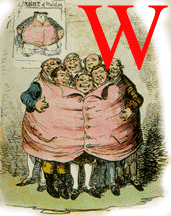 illiam Hogarth's works played an influential role on the PRB, both
stylistically as well as theoretically. His fusion of word and image, which
forced the viewer to connect them to better understand the moral meaning,
greatly influenced the PRB's use of significant verbal elements in their
paintings. Theoretically, Hogarth's idea that the artist's function as a
middle-class rooted prophet whose crusade to discipline the populace and
help disseminate morality to the masses was also adopted by some of the
members of the PRB. Hogarth was viewed as an individualist who aimed to
expand the traditional view of good English art and made his way past
critics in order to fulfil his artistic duty. In volume I of Hogarth's
Graphic Works, it states that he claimed his works should not be viewed as
"contemptible caricatures" but a new genre that was in "between the sublime
and the grotesque."
illiam Hogarth's works played an influential role on the PRB, both
stylistically as well as theoretically. His fusion of word and image, which
forced the viewer to connect them to better understand the moral meaning,
greatly influenced the PRB's use of significant verbal elements in their
paintings. Theoretically, Hogarth's idea that the artist's function as a
middle-class rooted prophet whose crusade to discipline the populace and
help disseminate morality to the masses was also adopted by some of the
members of the PRB. Hogarth was viewed as an individualist who aimed to
expand the traditional view of good English art and made his way past
critics in order to fulfil his artistic duty. In volume I of Hogarth's
Graphic Works, it states that he claimed his works should not be viewed as
"contemptible caricatures" but a new genre that was in "between the sublime
and the grotesque."
In many of his works, such as The Industrious Apprentice a Favourite and entrusted by His Master in his Industry and Idleness series, Hogarth emphasizes the importance of being an industrious member of the middle class and brings honor to the common worker. However, depending on the status of the viewer, one could have seen certain elements of his works as definite caricatures or categorize them as grotesque. In many of his other works related to poor choices made by amoral people, it is obvious as to what is being condemned and what is being upheld, however depending on the audience perhaps different elements could be viewed in a more "contemptible" light. If we compare Hogarth's work to David Wilkie's The Blind Fiddler, despite the fact that The Blind Fiddler does not send us any glaring moral messages, perhaps it could be said that both artists strive to create an image that is a favorable balance of the sublime and the grotesque, finding significance in the everyday world of humans and the choices of daily life.
Questions
1. Hogarth used Biblical verses to enhance his images and clarify their meaning. Do his works necessarily call for words to explain them or could they be successfully read on their own? (For example, to the illiterate viewer.) How did this differ from the relationship between word and image previously thought in the higher art world of the time?
2. Do you think that his works and their moral messages were understood by those whom he wanted to discipline?
3. What was the importance of having the artist identify as a member of the middle class? Did his target audience differ from those who actually bought his works?
4. Hogarth stated that the focus and subjects of his works were not "contemptible caricatures" but in "between the sublime and the grotesque"-- which elements of his works, such as The Industrious Apprentice a Favourite and entrusted by His Master could be seen as "contemptible caricatures" and by whom? What kinds of elements in his works keep him from categorizing them as either sublime or grotesque and which elements could fall into either group? Could this also be applied to Wilkie's The Blind Fiddler?
Last modified 14 September 2004